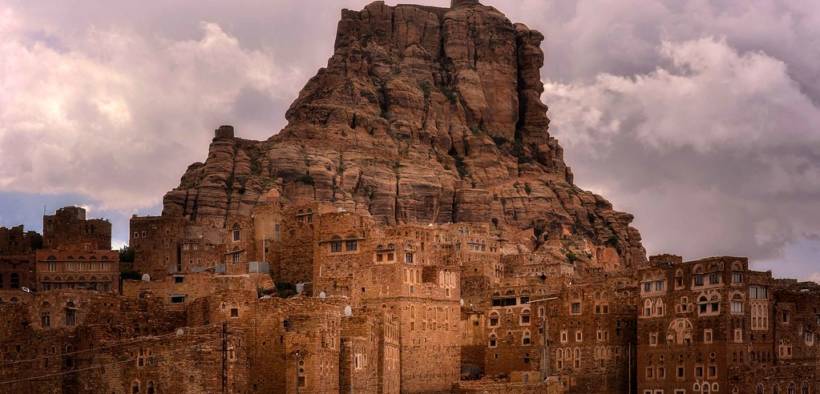Yemen’s Cultural Identity is Being Erased by War

“The destruction of their culture directly affects the identity, dignity and future of the Yemeni people, and moreover their ability to believe in the future.”
There is an important aspect of the war in Yemen has been so far ignored – under sustained bombing Yemen, an important world historical, religious and cultural landmark has seen its patrimony and its heritage disappeared, exploded and overall annihilated.
Whether such a campaign is by design or by default remains to be determined. It is nevertheless important at this stage to recognize that such loss of national cultural capital will gravely, and irrevocably affect the future of the impoverished nation – and beyond that of the entire region.
The loss of historical landmarks – mosques, shrines, UNESCO listed landmarks, museums and other precious reminders of Yemen’s rich and buoyant cultural makeup – will weigh heavy on both the economy and the country’s socio-religious fabric. Without a past to hold on to and associate with, without landmarks to remind a people of the bonds which unite them and make them who they are as a nation-state, Yemen could be claimed, and re-invented by such groups as al Qaeda, or ISIS.
Yemen, a country with three UNESCO world heritage sites – the Historic Town of Zabid, the Old City of Sana’a and the Old Walled City of Shibam – and a further ten on the organization’s tentative list, has suffered greatly since March 2015. As well as the large-scale loss of life, important historic sites have been severely damaged, more often than not, intentionally.
Countless other sites and cities are at risk of annihilation: Al Qahira Castle in Taiz, (10th century) which suffered damage during an airstrike in June 2015 according to UNESCO. And then Taiz museum in 2016 when a fire engulfed the premises.
The Old City of Sa’ada – founded in the 9th century and on UNESCO’s list – has also seen a number of its historic buildings destroyed. Sa’ada, like Sana’a, is of worldwide cultural importance due to the extensive survival of its medieval architecture – including its city wall and 16 gateways, houses, palaces and mosques – and its importance as an early center of Islamic learning. Sa’ada has almost completely disappeared under Saudi fire.
In July 2015, an emergency action plan for the safeguarding of Yemen’s heritage was announced by UNESCO with the goal of raising awareness, gathering information and providing technical assistance to heritage experts in Yemen.
Also in July 2015, the Old City of Sana’a and the Old Walled City of Shibam were added to UNESCO’s list of World Heritage in Danger – in reaction to Saudi Arabia’s involvement in the war.
The UNESCO-listed residential neighborhood of Fulayihi quarters has been hit by airstrikes.
A study conducted by the Shafaqna Institute for Middle Eastern Studies in collaboration with the Islamic Heritage Foundation established disturbing bombing patterns leading them to the conclusion that sites were being systematically targeted.
Speaking to the Middle East Eye in September 2015, Anna Paolini, UNESCO’s representative for the Gulf countries and Yemen slammed the kingdom for its intentional targeting of historical sites, warning that unless stopped such systematic destruction could claim more precious and irreplaceable sites.
On August 25, 2016, the ninth-century mosque of the Prophet Shuaibi in the Bani Matar area of Sana’a, was destroyed by an airstrike. The country’s General Organization of Antiquities and Museums and the General Organization for the Preservation of Historic Cities confirmed the destruction.
Beyond the evident loss of patrimony, questions pertaining to the intent behind such campaign beg answering. Should Yemen’s cultural, religious and historical heritage had been declared war on, as part of asymmetrical military campaign strategy, such actions might be categorized under war crimes.
Movable heritage has also suffered severe losses, as in the case of the Dhamar Museum, which used to host a collection of 12,500 artifacts, and which was completely destroyed in May 2015.
Taiz National Museum also suffered many attacks – ancient manuscripts were damaged and historic documents were burned.
More troubling still is the long term impact and social repercussions such a loss will carry to Yemen the nation-state. If we bear in mind that such radical groups as Daesh aka ISIL/ISIS or al Qaeda have been working to erase history so that they could raise their own dystopian and warped religious and socio-cultural markers, Yemen could be made ready for a re-engineering of a sort.
In August 2016, the Director-General of UNESCO, Irana Bokova described Yemenis’ plight accurately, saying: “It is evident that the destruction of their culture directly affects the identity, dignity and future of the Yemeni people, and moreover their ability to believe in the future.”
It has been unable so far to assess financial losses as such, as teams have yet to investigate the extent of the damage. Economically speaking, Yemen is expected to suffer a dramatic income loss on its tourism industry for years to come – maybe permanently in some cases.
In an interview, Amin Jazilan, former director-general of the Ibb tourism office confirmed that up until March 25, 2016, the Yemen tourism industry was well set to exceed yearly expectations. “According to Yemen Tourism Ministry, the tourism industry generated an annual income of $848 million in 2012 as opposed to $780 million in 2011,” he noted.
The war in Yemen has cost so far an average of $6 billion per month or $200 million per day. If such resources were spent towards reconstruction Yemen’s future would be secured.







